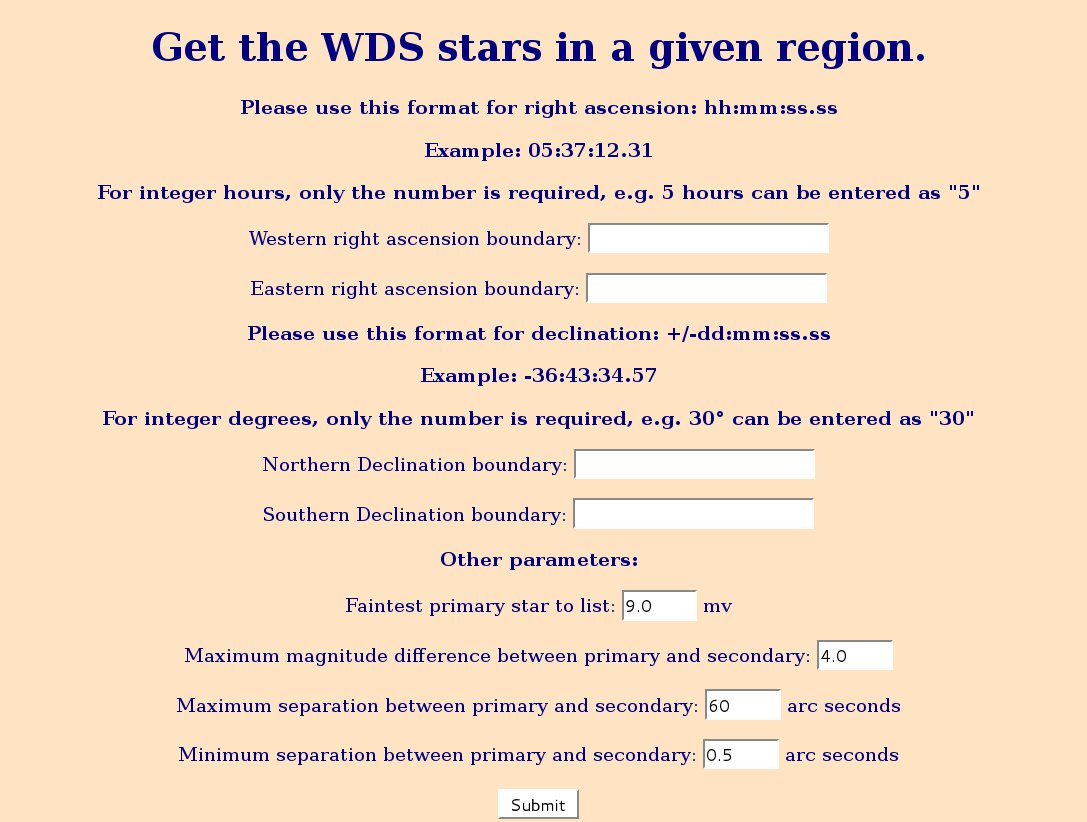Little Tycho Observatory
703 McNeill Road, Silver Spring, Md 20910
rkk_529@hotmail.com
An online tool that extracts entries based on user input from the Washington Double Star Catalog (WDS)1 has been created. It can be found at:
http://mainsequence.org/html/wds/getListOfDoubles/mkWDS_List.html
The data in the Washington Double Star Catalog are currently scattered over several files. Researching it requires perusing these files to find all of the data related to a given star, a time-consuming activity. To ameliorate this, the author has built a series of computer programs that assemble most of these data for a given group of binaries into a single, online, color-coded list.
When the http://mainsequence.org/html/wds/getListOfDoubles/mkWDS_List.html site is accessed, an initial menu is displayed:

The top four fields are for the right ascension and declination boundaries of the region you wish to search. These must be filled out, or the program will not run and it will return an error message to you.
The next four fields, labeled "Other parameters", specify the criteria for the search you're about to make. They are filled out with default parameters that you will probably want to change.
Clicking the Submit button will create the list.
The columns in the list are described in the explanation section, which can be accessed by clicking the "Explanation" tab in the third line of the list's header. We reproduce it here:
The data in this list a compendium of the United States Naval Observatory's main catalog, neglected stars, notes, and alternate star name list. The data in your list are taken from these documents and filtered according to your submitted specifications.
Row color explanation:Note: The data listed for all pairs are accurate, irrespective of the highlight color. The USNO gives a detailed explanation of neglected stars. Click here to go there.
The J2000 coordinates are formatted such that they can be copied into tools such as Aladin or WikiSky to display the DSS image at that location. The WDS Id is a 10 digit string that lists a low precision coordinate of the pair. The Dsc Id gives the discoverer's initials or designator, and the number of the pair in their published list. A mv is the visual magnitude of the primary. Other bandpasses for a pair are described in the notes column. B mv is the visual magnitude of the secondary. Spectra is the spectral type of the primary. At times the secondary's spectrum is listed as well. First and last θ are the the earliest and most recent position angles of the pair, in degrees. First and last ρ are the earliest and most recent separations, in arc seconds, of the pair. First and last Obs are the first year the pair was observed and the year of the most recent observation. AKA (Also Known As) lists other common names for the pair. Comments:Notes: If a star has an entry in the WDS notes document, the word "Note##" where ## is the number of the note appears in this column. Clicking on it will take you to the text of that note.
The search results are limited to a maximum of 500 binaries. After 500 binaries have been found, the search stops and the results are displayed.
The WDS is updated on a regular basis. The author attempts to update the database that contains the data shown by this list on a weekly basis as well.
The author wishes to acknowledge the editorial assistance of William Hartkopf, Tom Corbin, and Kathleen Bryant in making this short paper more readable.